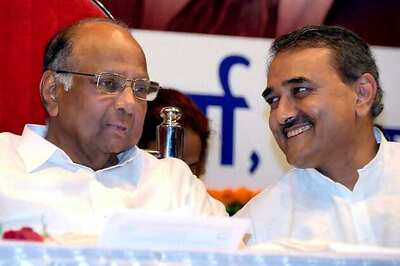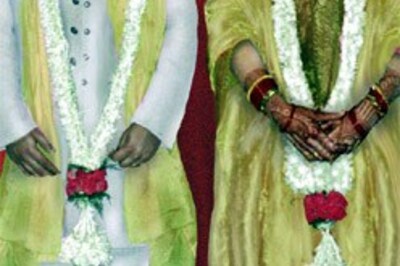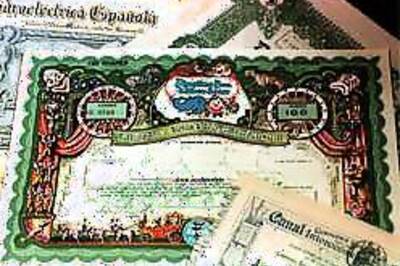
views
I wrote an article ten years ago, titled ‘The great Indian rope trick and other illusions of progress’ about how the average Indian is satisfied with illusion, never mind real progress. That made India a Potemkin State, where form is everything and substance is immaterial. It turns out that I was wrong. Indians do want actual progress. I might be pardoned for saying what I said then because the country was at the fag-end of a lost decade, 2004 to 2014, wherein things deteriorated steadily. Decline had been par for the course throughout the Nehruvian-Stalinist decades of dirigisme.
Apart from missteps in economic management, the political environment was also dicey. There was the appalling spectacle of a constitutional coup, as I noted at the time, by colluding with the Communist Speaker in the cash-for-votes scam, the Congress clung on to power violating democratic norms.
We see the same recklessness today in the US (“Let’s jail the leading opposition candidate”) and in Germany (“One party is getting too popular, let’s ban it”). It does not bode well. The New York Times, on August 21, 2023, ran a striking headline, ‘Elections Are Bad for Democracy’ before changing it to ‘The Worst People Run for Office. It’s Time for a Better Way’. Yes, democracy is too important to leave to the people. Let us elites tell them what to think.
The most striking example of this uncaring State, the very nadir of its contempt for the man in the street, was the length of the chain anchoring the mug in the loo in railway compartments: just three inches too short, thus shattering the illusion that you could actually clean your bottom. A daunting prospect for any traveller, especially because of the overwhelming stink, and a world of difference from Japan’s shinkansen and their amazing high-tech loos.
Recently, I travelled in several train compartments, including ancient Jan Shatabdi chair cars and newish Hamsafar sleeper coaches, although, alas, not in Vande Bharat coaches yet; but I was surprised at how much better the toilets were. The ‘bio toilet’ means human faeces are not dumped on the tracks; they do not smell terrible, and, wonder of wonders, there is a hygiene hose/bidet that is actually long enough to do the deed. And, perhaps redundantly, the chain for the mug has been lengthened. And there is water!
It is hard to explain to a non-Indian what a difference all this makes. I had a cousin who denied herself food and drinks while travelling by train just so she could avoid the toilet. It is a sea change when you are granted a little self-respect. I am reminded of the placard held by a man at a Martin Luther King rally: “I am a man”. Yes, the proverbial average Indian aam aadmi is a human who deserves consideration: not only Lutyens and Khan Market types.
I am sorry to talk about toilets, but this is something earthy and immediately understandable; it makes the point that India is, 76 years after the imperialists left and brown sahebs took over, finally on the march. Indians are beginning to see that they can demand respect from their rulers, and get it. Dignity, the watchword of the butler Stevens in Kazuo Ishiguro’s brilliant The Remains of the Day.
In a penetrating 1997 essay, ‘India shouldn’t have fantasies about the past, but face it’, Sir V S Naipaul mentioned that those who have been oppressed and denigrated for centuries are now rising, and this rise will be messy. He was talking about those outside the charmed circle that ruled the country for long. It is also broader: the rise of the Other Backward Communities, that uncharming name for the majority of Indians, the Bahujan.
Naipaul also said that the rulers will now, of necessity, be of the people, not overlords. It can be argued that for over a thousand years, Indians have been effectively ruled by a comprador ‘elite’, middlemen who did the dirty work on behalf of invaders or distant rulers. It is my suspicion that the zamindars and other local strongmen were largely from the upper or middle jatis, and it is only now that those from the bottom of the pyramid are finally getting a say in things.
No, this is not a jati-bashing exercise, and I may be extrapolating from my observations in Kerala, where a middle jati, Nairs, were the kulaks who lorded it over those below them in the hierarchy, such as OBC Ezhavas, SC Pulayas, and ST Mala-arayans. The latter are now rising, though not in full measure, yet. I think it’s similar in Tamil Nadu, too.
In the Soviet Union, Stalin liquidated the kulaks. In India, their eclipse has come about too late, though without violence. The usual woke Lutyens/Khan Market suspects were disappointed they couldn’t chortle about Chandrayaan-3 being yet another expensive failure a poor country could ill afford, echoing Brits upset that their alleged ‘aid’ was going to India (in reality, as per the UK Foreign Office, India politely declined any charity from them starting 2015; any money coming to India from the UK is foreign direct investment (FDI), or strictly in support of their geopolitical objectives, channelled via dubious NGOs or missionaries).
The ‘wokes’ also grumbled about ISRO engineers going to Tirupati and invoking the blessings of the Divine for their project. I am glad they got a muh tod jawab. There really is no dichotomy in Hindu thought between science and faith: science too requires faith and belief.
The ‘wokes’ have reason to be worried, not only by the picture-perfect moon landing but also by Praggnaanandhaa, who almost unseated the reigning World Champion in chess; Neeraj Chopra, who won the World Athletic Championship in javelin to go with his Olympic gold; the 4×400 relay quartet with their heroics of almost defeating the Americans in the heats while setting an Asian record; and Vivek Ramaswamy, who is unabashedly Hindu and at the same time a patriotic American and a force to contend with in the Republican party in the US.
Even though they haven’t been defenestrated, except perhaps some unfortunate folks at Ashoka University, India’s Left are less and less relevant: relics of a failed ideology. They should count their lucky stars: in Singapore, Lee Kwan Yew liquidated them. And indeed, even in the US, the ‘woke’ capital of the world, their star is setting.
There is another reason I brought up toilets: the unseemly obsession that Westerners have with them. I was delighted to see this cartoon on Twitter, and it is obviously a parody of the earlier one in The New York Times.
While the racist derision of the original cartoon, and the celebration of the women in Indian engineering are the obvious takeaways, I was intrigued by a detail: the white guy in the cartoon is dragging a shopping cart full of toilet paper behind him! I am not sure why toilet paper is some kind of atavistic guilty pleasure for Westerners.
Despite being purely climate-related (they could not afford to melt ice and snow just to wash their bottoms, or for that matter their hands, thus cutlery), toilet paper has become a cultural staple for them. You might remember the hoarding of toilet paper in the early days of Covid! It’s time Westerners abandon killing trees, and go for the more healthy bidet-like health faucet. For that matter, the squat in Indian closets is apparently better than the sitting posture on a western ‘thunder-box’. Recently, while travelling in the Czech Republic, I stayed in a (fancy) hotel that had a bidet: such a relief! May their tribe increase.
Of course, some things never change. This was demonstrated in two ways: the thinly-veiled envy from the British that manifested itself in their assertion that an India full of open defecation shouldn’t be spending on space research, and The Economist magazine in their recent obituary of Bindeswar Pathak repeatedly emphasising caste discrimination and manual scavenging. These are vestiges of the past, and mostly due to the $10 trillion (or $45 trillion depending on whom you ask) that the Brits looted, impoverishing India. But then, who’s counting? And you want to talk about open defecation? Once-beautiful San Francisco is now the champion, while India has built large numbers of indoor toilets all over the country. See the ‘poop map’ of San Francisco here.
One thing that has definitely changed in the last ten years is the amount of Hindu hatred expressed in the West, particularly in America. The California caste Bill, Equality Labs, Audrey Truschke, and the latest, tech journo Kara Swisher’s racist attack on Vivek Ramaswamy, are all related to the fact that Hindus have quietly become one of the most economically successful (but politically powerless) groups in the US. It is really a back-handed compliment, happily cheered on by rogues from the “Chindu” stable or similar. Caste is the weapon. Hindus tend to be defensive about caste. We shouldn’t be. Caste is really a white invention, from the Portuguese casta, intended to segregate mixed-race people based on how white they are, half, quarter, one-eighth, etc: thus mulatto, quadroon, octroon, etc. It is their cross to bear. There is an ocean of difference between this caste business and jatis, but I digress.
Besides, there are de facto castes in the US: the investment banker caste, the doctor caste, the lawyer caste, the management consultant caste, etc. They all go to the same Tony prep schools, the same Ivy League colleges (legacy admissions mean you easily get into Harvard, if your parent(s) went to Harvard, regardless of your grades. Raj Chetty has published reams of data about this); they are endogamous; and they all miraculously end up at Goldman Sachs or McKinsey. An outsider can’t break in. These castes are also Lindy (ask Nassim Taleb).
Perhaps, taking a cue from other groups that have prospered, Hindus (and Indian Americans in general) are becoming ‘white’, as others have before them. Irish, Italians, Jews, Japanese, Koreans, Chinese: there is a long list. ‘Whiteness’ is a construct. I was flabbergasted decades ago when a well-meaning white guy said, “You guys are almost white”. I stuttered: “But, but… we are brown!”. If you have money, you pretty much become white. I give it another ten years. With India’s GDP at $10 trillion dollars, and more Hindu Americans creating unicorns, I bet by 2034, Hindus will be ‘white’. Maybe Vivek is the first white Hindu. I am not making a value judgment, merely making a prediction. You heard it here first.
The writer has been a conservative columnist for over 25 years. His academic interest is innovation. Views expressed in the above piece are personal and solely that of the author. They do not necessarily reflect News18’s views.


















Comments
0 comment